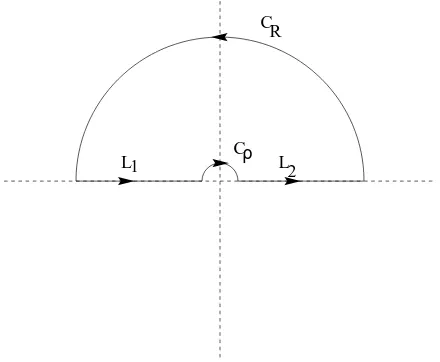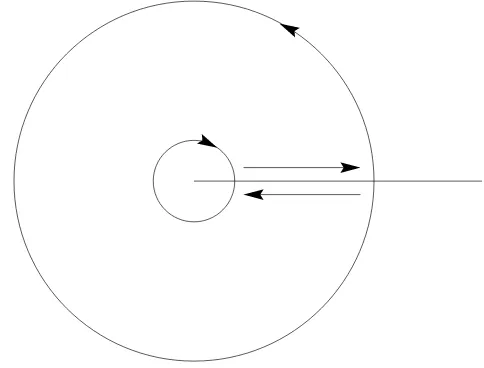sinz
You only need the first two terms.
(b)
Res z=0
cosz
sinz = 1 2. Calculate the integral
Z
|z|=5
1−cosz
sinz dz .
(where the circle|z|= 5 is positively oriented).
Solution: The only singular points inside the circle are at
z0=−π, z1= 0, z2=π .
The residues there are
Res
Therefore the value of the integral is
C
Cρ R
L1 L
2
Figure 1. A contour, withρ(the radius ofCρ) small, andR(the radius ofCR) large.
3. Show that
Z ∞
−∞
sinx x dx=π
by integration of the function
f(z) = e iz
z
along a contour like that shown in figure 1.
Solution: See page 220 of Churchill & Brown.
4. Calculate
Z
|z|=100 dz
sin(1/z)
where the circle|z|= 100 is positively oriented.
Solution: The singular points are the simple poles
z= 1
πN
w=0 w2w 1−w
Another way to try to solve the problem: we could try to add the infin-itely many residues inside the circle. This doesn’t actually work, surpris-ingly, since the singular points accumulate toz= 0. Let us try it anyway. We can expand (but you don’t need to):
1
There is also an essential singularity atz= 0 which looks like 1 This appears to give
Z
The fact that the series
X
is not obvious. It suggests a value of 2πi/3 for the integral, which is incor-rect. Either approach gets full points, although the residue at infinity gives the right answer and is much easier.
The reason why the second approach doesn’t work is that the expansion at z = 0 is not actually valid in any region around z = 0, since there are poles in every such region. It is really only an asymptotic series, not a convergent Laurent series.
5. Bonus: Calculate
Z ∞
0
Figure 2. Integrating along the branch, then around a large
cir-cle, then backwards along the branch, and then around a small circle.
Solution:
Z ∞
0
dx
x1/4(x+ 4) =π .
I arrived at this by integration of the function
f(z) = 1
z1/4(z+ 4)
along the branch cut, setting
z1/4=r1/4eiθ/4
whenever
0< θ <2π
with
z=reiθ.
We integrate along a contour like that shown in figure 2. The only singu-larity off the branch is atz=−4, where the residue is
Res z=−4
1
z1/4(z+ 4) =
1 (−4)1/4
=√ 1
2eπi/4
=√ 1
2 1/√2 +i/√2
= 1
1 +i
R R5/4 =R
−1/4 →0
while for smallRis of order
R R1/4 =R
3/4 →0.
So we can ignore these circular arcs, and find that the limit of the contour integral (as the large circle gets very large and the small one very small) is
Z ∞
0
dx x1/4(x+ 4)+
Z 0
∞
dx
x1/4eiπ/2(x+ 4) = (1 +i)
Z ∞
0
dx x1/4(x+ 4) .
But this must equal
2πiRes
z=−4f(z) = 2πi
1−i

